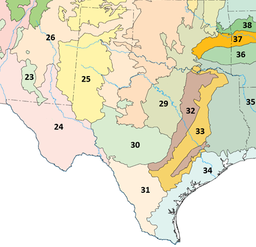Texas Blackland Prairies
| Texas Blackland Prairies | |
|---|---|

Texas blackland prairies (area 32 on the map)
|
|
| Ecology | |
| Realm | Nearctic |
| Biome | Temperate grasslands, savannas, and shrublands |
| Borders | East Central Texas forests (area 33 on the map), Edwards Plateau (area 30 on the map) and Cross Timbers (area 29 on the map) |
| Bird species | 216 |
| Mammal species | 61 |
| Geography | |
| Area | 50,300 km2 (19,400 sq mi) |
| Country | United States |
| State | Texas |
| Conservation | |
| Habitat loss | 76.458% |
| Protected | 0.64% |
The Texas blackland prairies are a temperate grassland ecoregion located in Texas that runs roughly 300 miles (480 km) from the Red River in North Texas to San Antonio in the south. The prairie was named after its rich dark soil.
The Texas blackland prairies ecoregion covers an area of 50,300 km2 (19,400 sq mi), consisting of a main belt of 43,000 km2 (17,000 sq mi) and two islands of tallgrass prairie grasslands southeast of the main blackland prairie belt; both the main belt and the islands extend northeast/southwest.
The main belt consists of oaklands and savannas and runs from just south of the Red River on the Texas-Oklahoma border through the Dallas–Fort Worth metropolitan area and into southwestern Texas. The Central forest-grasslands transition lies to the north and northwest, and the Edwards Plateau savanna and the Tamaulipan mezquital to the southwest.
The larger of the two islands is the Fayette Prairie, encompassing 17,000 km2 (6,600 sq mi), and the smaller is the San Antonio Prairie with an area of 7,000 km2 (2,700 sq mi). The two islands are separated from the main belt by the oak woodlands of the East Central Texas forests, which surround the islands on all sides but the northeast, where the Fayette Prairie meets the East Texas Piney Woods.
This area was shaped by frequent wildfires and Plains bison. Large fires ignited by lightning would frequently sweep the area, clearing shrubs and stimulating forbs and grasses. Large herds of bison also grazed on the grasses, and they would trample and fertilize the soil stimulating the growth of the tallgrass ecosystem. Hunter-gatherers contributed to the formation and expansion of the prairie through controlled burns to make more land suitable for hunting bison and other game. Hunter-gatherers continually inhabited the prairie since Pre-Clovis times over 15,000 years ago. In historic times, they included the Wichita, Waco, Tonkawa, and Comanche, each of whom were gradually replaced by settled agrarian society. The advent of large-scale irrigated farming and ranching in the area ended the expansionary period in the prairie's formation and quickly led to widespread habitat loss.
...
Wikipedia
